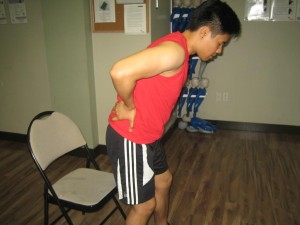Back strain is a prevalent injury among professional athletes and in the workplace or even at home. Back strain occurs when one of the muscles that provide support to the spine is pulled, torn or twisted.
Sports that include a lot of jumping such as volleyball and basketball can put an individual at higher threat for back strain. Even softball or golf can lead to back strain. Individuals who are overweight or out of shape are at risk. In addition, those who had previous injuries to the back face a high risk.
In case a family member experiences back strain, knowing how to care for the injury can help minimize the pain as well as allow the individual to resume his/her activity as soon as possible. Of course, you should also know when it is time to consult a doctor. If it is more than just a minor strain, medical care might be required to prevent permanent damage. If you want to be prepared to manage this injury, all you have to do is to enroll in a class on first aid today.

What are the symptoms of back strain?
- Pain
- Swelling
- Muscle weakness or loss of functionality
- Muscle cramping or spasms
A mild case of back strain can be treated at home but a doctor should be consulted as soon as possible if the following symptoms are present:
- Severe swelling or pain
- Pain that interferes with sleep
- Pain that makes it hard to walk or move
- Numbness in the affected area or down the leg
What to do for the first 48 hours
During the first 2 days after the back strain, the objective of treatment is to reduce the pain, swelling and muscle spasms.
- The individual should avoid any activity and exercise for 1-2 days if needed.
- Apply an ice pack over the injured area at 20 minutes at a time for 4-8 times throughout the day. Continue the application for 48 hours after the injury. During this period, the ice reduces the inflammation by constricting the blood vessels to limit the blood flow to the area.
- Over-the-counter NSAIDs such as ibuprofen, aspirin or naproxen can help relieve the swelling and pain.
What to do after two days
Since the back is sore, many find it best to stay in bed for a week. On the other hand, it is better to resume normal activities as quickly as possible. Prolonged rest and immobility will only delay the recovery.
After the first few days, apply heat to the injured site to ease the pain by relaxing the tight muscles. You can use a hot compress, heating pad or heat lamp. Heat works by dilating the blood vessels which increases the flow of blood to the area. This promotes healing as blood brings in vital nutrients and carries away debris from the damaged tissues.
It is important to note that in most cases, the symptoms of back strain typically vanish within two weeks. If the symptoms persist, a doctor should be consulted.
